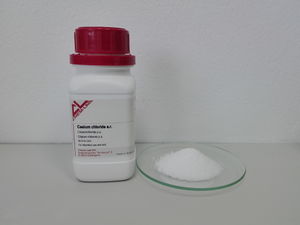Caesium chloride
 Caesium chloride sample
| |
| Names | |
|---|---|
| IUPAC name
Caesium chloride
| |
| Other names
Cesium chloride
Cesium monochloride | |
| Properties | |
| CsCl | |
| Molar mass | 168.36 g/mol |
| Appearance | White hygroscopic solid |
| Odor | Odorless |
| Density | 3.988 g/cm3 |
| Melting point | 646 °C (1,195 °F; 919 K) |
| Boiling point | 1,297 °C (2,367 °F; 1,570 K) |
| 162.0 g/100 ml (0 °C) 186.5 g/100 ml (20 °C) 191.0 g/100 ml (25 °C) 270.5 g/100 ml (100 °C) | |
| Solubility | Soluble in ethanol, conc. HCl, hydrazine, methanol Insoluble in acetone |
| Solubility in acetonitrile | 0.0083 g/100 ml (18 °C) |
| Solubility in acetone | 0.003 g/100 ml (25 °C) |
| Solubility in ammonia | 0.38 g/100 ml (0 °C) |
| Solubility in ethanol | 0.76 g/100 ml (25 °C) |
| Solubility in formic acid | 107.7 g/100 ml (18 °C) |
| Vapor pressure | ~0 mmHg |
| Hazards | |
| Safety data sheet | Sigma-Aldrich |
| Flash point | Non-flammable |
| Lethal dose or concentration (LD, LC): | |
| LD50 (Median dose)
|
2,300 mg/kg (mouse, oral) 910 mg/kg (mouse, IV) 2,600 mg/kg (rat, oral) |
| Related compounds | |
| Related compounds
|
Lithium chloride Sodium chloride Potassium chloride Rubidium chloride |
| Except where otherwise noted, data are given for materials in their standard state (at 25 °C [77 °F], 100 kPa). | |
| Infobox references | |
Caesium chloride or cesium chloride, is the inorganic compound with the formula CsCl.
Contents
Properties
Chemical
Addition of a strong acid, like sulfuric acid, will release hydrochloric acid.
- 2 CsCl + H2SO4 → Cs2SO4 + 2 HCl
At high temperatures, magnesium will reduce caesium chloride to give caesium metal.
- 2 CsCl + Mg → 2 Cs + MgCl2
Caesium chloride forms a variety of double salts with other chlorides. Examples include 2CsCl·BaCl2, 2CsCl·CuCl2, CsCl·2CuCl and CsCl·LiCl, and with interhalogen compounds
Physical
Caesium chloride is a hygroscopic colorless solid, extremely soluble in water.
Availability
Caesium chloride is sold by chemical suppliers.
Preparation
Can be prepared by neutralizing caesium hydroxide or carbonate with hydrochloric acid.
- 2 CsOH + HCl → CsCl + H2O
Projects
- Make blue-violet flame
- Make caesium metal
- Make caesium hydroxide via electrolysis
- Solute for ultracentrifugation
Handling
Safety
Caesium chloride has low toxicity, with a median lethal dose (LD50) in mice of 2,300 mg/kg of body weight for oral administration and 910 mg/kg for intravenous injection. When taken in large quantities, however, can cause a significant imbalance in potassium and lead to hypokalemia, arrythmia, and acute cardiac arrest.
Storage
In closed bottles.
Disposal
Since caesium is difficult to find, it's best to try and recycle it.